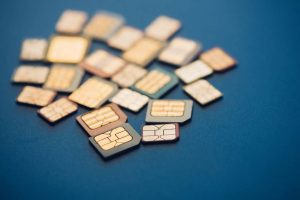If you’ve recently switched phones, you might be worried about the compatibility of your SIM card on both devices. First, let’s dive into an overview of SIM cards, the types, and if we can find SIM cards universal for Android and iPhones.
SIM cards safely store the service key of the subscriber used to identify themselves to the phone operators. There are mainly three types of SIM cards in use. They are the Standard SIM, the smaller Micro SIM, and the smallest of them, the Nano SIM.
- Standard SIM Card: The Standard SIM card remains the largest of the three types of SIM cards and is the oldest. It was generally used in phones before 2010, with some exceptions. The Standard SIM measures 25x15mm and is also known as 2FF. It is very hard to find a phone using Standard SIM, but it may sometimes be found on basic feature phones.
- Micro SIM Card: The Micro SIM card is similar to a Standard SIM card, except that extra plastic around the circuit board has been removed. The only real difference between a Standard SIM and a Micro SIM is the size of the plastic around the microchip.
The Micro SIM card was developed to make smartphones slimmer and lighter. High-end brands like Apple and Samsung were the first to introduce the Micro SIM chip on their devices.
- Nano SIM Card: This new kid on the block is used on most of the latest devices. The Nano SIM card is almost 50 % smaller than a Micro SIM, measuring 12.3×8.8mm. It first made its appearance in the Apple iPhone 5.
Are sim cards universal for Android and iPhones?
No, SIM cards are not universal. In general, you can only use SIM cards from GSM carriers on compatible phones. So, you must check your SIM card to see what size it is, the carrier, the country where the carrier is operating, and confirm that your Android or iPhone isn’t locked to a specific carrier.
On the other hand, almost all phones from the same brand and model tend to have the same SIM card sizes irrespective of the country where said device is being sold.
SIM card compatibility chart for Samsung
If not the biggest, Samsung is one of the leading phone brands for Android devices. They are the closest rival to Apple and their iPhone brand. Samsung SIMs also answer the question, “are SIM cards universal for android and iPhones?”. Check out a chart showing the sizes of SIMS and the Samsung devices they are compatible with.
| SAMSUNG MODEL | SIM SIZES |
| Samsung Galaxy A10e, A20, A50, Samsung Galaxy A01, A11, A42 5G, A51/A51 5G, A52 5G, A71 5G, Samsung Galaxy A03s, A12, A13 5G, A21, A32 5G , Samsung Galaxy S6, S6 Active S6 Edge, S6 Edge Plus Samsung Galaxy S7, S7 Edge, S7 Active Samsung Galaxy S8, S8+, S8 Active Samsung Galaxy S9, S9+ Samsung Galaxy S10, S10+, S10e, S10 5G Samsung Galaxy S20, S20+, S20 Ultra 5G Samsung Galaxy S21 5G, S21+ 5G, S21 Ultra 5G Samsung Galaxy S22 5G, S22+ 5G, S22 Ultra 5G Samsung Galaxy Note 5, 7, 9 Samsung Galaxy Note 10, Note10 5G, Note10+, Note10+ 5G Samsung Galaxy Note 20, Note20 Ultra, Note20 Ultra 5G Samsung Galaxy Express Prime 3 Samsung Galaxy J3 (all models) Samsung Galaxy J7 (all models after 2016) Samsung Galaxy J8 | Nano SIM |
| Samsung Galaxy Fold Samsung Galaxy Fold 5 Samsung Galaxy Z Fold2 5G Samsung Galaxy Z Fold3 5G Samsung Galaxy Z Flip, Z Flip 5G Samsung Galaxy Z Flip3, Z Flip3 5G | Nano SIM/eSIM |
| Samsung Galaxy Core Prime Samsung Galaxy Express Prime Samsung Galaxy Express Prime 2 Samsung Galaxy J2 Samsung Galaxy J7 (2016) | Micro SIM |
The eSIM appeared in a few of the Samsung models in the chart. They stand for electronic SIM, meaning your SIM card will be available electronically instead of a physical SIM. Most new devices employ this type of SIM card.
List of phones that use standard SIM cards
Standard SIMs are now looking obsolete with the emergence of the Micro, Nano, and even eSIM cards to put them out of the market. However, some old devices and phones still use the Standard SIM card. Here is a list of popular phone brands that use Standard SIMs.
Phone/Device
- Apple iPhone 3GS Standard SIM
- Apple iPhone 3G Standard SIM
- Apple iPhone Standard SIM
- Samsung Galaxy S Duos 2 Standard SIM
- Samsung Galaxy S II Plus Standard SIM
- Samsung Galaxy S3 Mini Standard SIM
- Samsung Galaxy S3 Progre Standard SIM
- Samsung Galaxy S Duos Standard SIM
- Samsung Galaxy S Advance Standard SIM
- Samsung Galaxy S2 Standard SIM
- Samsung Galaxy SL Standard SIM
- Samsung Galaxy S Standard SIM
- Samsung Galaxy Xcover 3 Standard SIM
- Samsung Galaxy Y Standard SIM
- Samsung Galaxy Young Standard SIM
- Samsung Nexus S Standard SIM
- Samsung Galaxy K zoom Standard SIM
- Samsung Galaxy Music Standard SIM
- Samsung Galaxy Nexus Standard SIM
- LG L60 Dual Standard SIM
- LG L Fino Standard SIM
- LG Realm Standard SIM
- LG L65 Standard SIM
- LG L35 Standard SIM
- LG L80 Dual Standard SIM
- LG L65 Dual Standard SIM
- LG Optimus Exceed 2 Standard SIM
- LG L90 Dual Standard SIM
- LG L70 Standard SIM
- LG L70 Dual Standard SIM
- LG L40 Standard SIM
- LG L40 Dual Standard SIM
- LG Optimus L1 II Tri Standard SIM
- LG Optimus F3Q Standard SIM
- Huawei Honor 3X Pro Micro SIM, Standard SIM
- Huawei Honor 3X Lite Micro SIM, Standard SIM
- Huawei Honor 3X Micro SIM, Standard SIM
- Huawei Ascend P1 Standard SIM
- Huawei Y541 Standard SIM
- Huawei Ascend Y540 Standard SIM
- Huawei Ascend Y520 Standard SIM
- Huawei Ascend Y530 Standard SIM
- Huawei Y3 U12 Micro SIM, Standard SIM
- Huawei Y3 U03 Micro SIM, Standard SIM
- Huawei Ascend Y330 Micro SIM, Standard SIM
- Huawei Ascend Y320 Standard SIM
- Huawei Ascend Y300 Standard SIM
- Huawei Ascend G300 Standard SIM
- Huawei Ascend G330 Standard SIM
- Huawei Ascend G510 Standard SIM
- Xiaomi Mi Note Pro Micro SIM, Standard SIM
- Xiaomi Mi Note Micro SIM, Standard SIM
- Xiaomi Mi 3 Standard SIM
- Xiaomi Mi 2A Standard SIM
- Xiaomi Mi 2S Standard SIM
- Xiaomi Mi 2 Standard SIM
- Xiaomi Mi 1S Standard SIM
- Xiaomi Mi 1 Youth Edition Standard SIM
- Xiaomi Mi 1 Standard SIM
- BlackBerry 9720 Standard SIM
- BlackBerry Bold Touch 9900 Standard SIM
- BlackBerry Curve 9320 Standard SIM
- BlackBerry Curve 9360 Standard SIM
- BlackBerry Torch 980000 Standard SIM
- BlackBerry 9720 Standard SIM
- BlackBerry Bold Touch 9900 Standard SIM
- BlackBerry Curve 9320 Standard SIM
- BlackBerry Curve 9360 Standard SIM
- BlackBerry Torch 9800 Standard SIM
Read also: Do I Need A New Sim Card and Phone for 5G?
What happens if you take out your SIM card and put it in another phone?
Some people often switch their SIM cards from one device to another. But what happens when one does this switching? Well, if the phone you are switching to is compatible with your SIM card, calls and text messages will be received on the phone. However, old text messages and calls won’t show up on the phone. This is because data such as calls and text messages are stored on the device and not the SIM card.
If you save your contacts on your SIM card, they will be displayed when you put the SIM card in the other phone. However, if you do not copy the contacts to your phone, they will disappear once you remove the SIM card.
There are some other things to know. For example, if your device is locked to a specific carrier, inserting another carrier’s sim card may not work. So, if you’d like your device to work universally irrespective of the sim card you insert, you’d either want to unlock or ensure that it’s not locked to any carrier.
Read also: Do I Need A Sim Card in Both Phones to Use Samsung Smart Switch?
Are SIM cards made for specific phones?
Since SIM cards come in three different sizes, the size that your phone accepts will depend on the phone’s brand, size, and date of manufacture. As such, when you want a new SIM card, you need to know which size your phone is compatible with and order one of the correct sizes.
Fortunately, most cellular carriers have handled this issue very well. When you order a SIM card from a popular provider, they’ll give you a Standard-sized one. However, the SIM card will have perforations that allow you to transform it into its Micro or Nano forms by tearing parts off it.
If you use an iPhone or an Android device and you are wondering if there are SIM cards universal for Android and iPhone, then you may have most likely gotten your answer from this article. Standard SIMs are fast becoming obsolete, and it is now the age of micro, nano, and eSIMs.
For more information on the type of SIM card your device is compatible with, check out the specifications on the box. The SIM card may be universal for Android and iPhone, but the device will also determine if it is or not.




